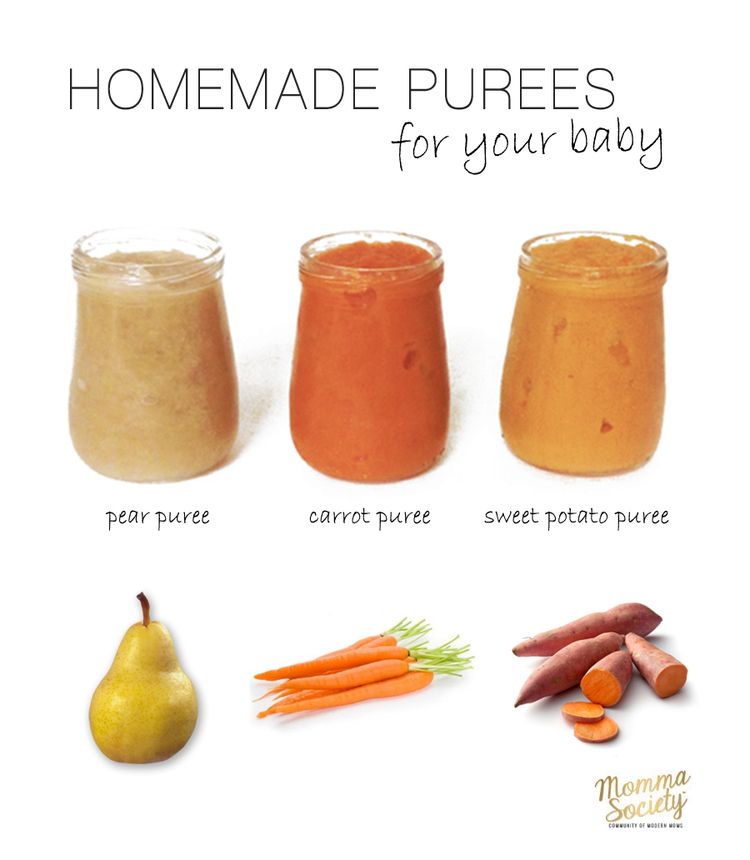List of finger foods for 9 month old baby
Best Finger Foods for Babies: The Ultimate Guide
How exciting that your baby is about to graduate from mushy foods to finger foods! This is a big step in your little one’s development. However, you may be wondering when’s the right time to start finger foods, and how to tell that your baby is ready. We’ll answer all these questions and more, plus give you a list of the best finger foods to introduce to your baby first.
Introducing Finger Foods to Your Baby
So, when can babies eat finger foods? You can start to give your baby finger foods around the time they’re able to sit up independently and can bring their hands to their mouth. This may happen between the ages of 8 months old and 9 months old, but your baby may be ready a little sooner or later than this time.
Around this time, you may also notice that your baby is developing their pincer grasp and may be making chewing motions. These are both great indications that your baby’s ready for finger foods. Moreover, using their fingers to pick up foods will further develop your baby’s fine motor skills.
Some parents who adopt the baby-led weaning approach may start offering finger foods to their infants as early as 6 months old. This method skips spoon-feeding with solid foods and instead lets your baby take the lead in self-feeding with finger foods. Some believe this approach can decrease fussiness when it comes to introducing new foods, including finger foods, to your baby. Speak to your child’s healthcare provider if this method is something you’d like to try.
Giving your baby finger foods can help your little one learn to feed themself, just one step toward gaining independence. Self-feeding can be great fun for your baby. Even if much of the food doesn’t end up in your baby’s mouth, the fact that they’re exploring this new frontier is an accomplishment to be proud of.
First Finger Foods for Your Baby
As you begin choosing finger foods for your baby, check out the following ideas:
Steamed veggies like sweet potatoes, potatoes, carrots, green beans, peas
Soft, ripe fruits like bananas, berries, peaches (peeled), mangoes (peeled)
Whole-grain breakfast cereals (without nuts, clusters, or chunks)
Whole-grain pasta (cooked well)
Whole-wheat bread
Whole-grain crackers or wafers like teething biscuits
Soft meats like chicken
Cheese (mild)
Scrambled eggs.

Be sure that any of the above finger foods are cut into small pieces. You don’t want your baby eating a piece that’s too big to swallow. And, make sure to watch them while eating.
Finger Food Safety
During this time babies are more likely to swallow foods without chewing them, whether they have a few baby teeth coming in or they have no teeth. Avoid giving any finger foods that require a grinding action to chew (this type of chewing is typically mastered around the age of 4), as these may pose a choking risk. Offer finger foods that are soft, easy to swallow, and broken or cut into pieces that your baby cannot choke on. A good rule of thumb is that soft and mushy finger foods are safe for your baby. Small, round, coin-shaped, hard, chewy, crunchy, slippery, or sticky foods may lead to choking. Here are some foods to avoid offering your baby when they start on finger foods:
Peanut butter (in chunks)
Meat (in chunks)
Cheese (in chunks)
Raw veggies (in large chunks or round shapes), including celery sticks, carrot sticks, baby carrots, cherry tomatoes, and peas
Raw hard fruit (in large chunks or round shapes), including apples, pears, and grapes
Nuts (whole)
Seeds
Popcorn
Chewing gum
Candies (hard, gooey, or sticky)
Hot dogs or meat sticks.

There are ways you can still give some of the above foods while making them easier to eat and less hazardous to swallow. For example:
Grapes or cherry tomatoes, cut in half
Creamy peanut butter spread thinly on whole-grain bread that’s cut into small squares
Hot dog, cut lengthwise and then cut into small 1/2-inch pieces.
Note on Food Allergies
Medical experts once recommended that parents avoid feeding their babies eggs, fish, and peanut butter since babies may be allergic to these foods. However, it’s now recommended that you introduce these foods early—while keeping a close watch for any reactions—since this approach can help reduce your child’s chances of developing food allergies. Before introducing peanut butter or peanut products, consult with your baby’s healthcare provider. Your baby is more likely to be allergic to these foods if
food allergies run in your family
your baby is known to have an egg allergy
your baby has eczema.
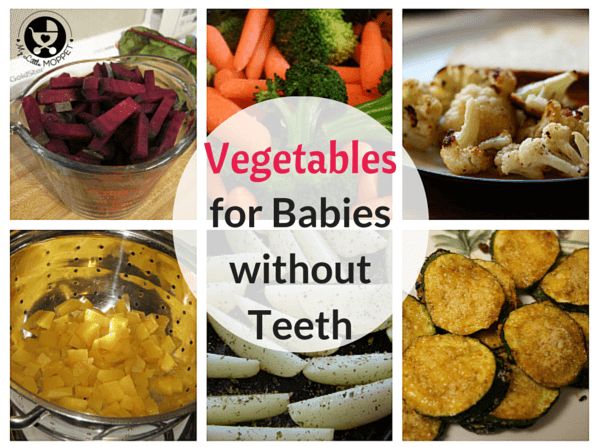
The Bottom Line
It’s time to introduce finger foods to your baby when you see that they’re able to sit up on their own, start bringing their hands to their mouth, and can use a pincer grasp to hold onto small items, like finger foods. This development happens around the age of 8 or 9 months old, but you may see it sooner or later in your baby.
In the beginning, you’ll want to introduce finger foods that are soft and easy to swallow, since babies at this age tend to swallow instead of chew even if they have a few baby teeth. Think steamed veggies and soft fresh fruits. You can also introduce whole-grain bread, crackers, cereal, or pasta if they’re cut into small pieces. Chicken, mild cheese, and scrambled eggs are also great options when served in small pieces.
Avoid hard foods like raw veggies and fruits, as well as chunks of nut butter, cheese, and meat. Whole nuts and seeds are not recommended, nor are chewing gum, candies, hot dogs, or meat sticks. All these items can pose a choking hazard.
All these items can pose a choking hazard.
Transitioning to finger foods is a big step in your baby’s development and independence. Letting your baby self-feed with finger foods may be a bit messy at first, but you’ll both get the hang of it. Learn more about developmental milestones for your 9-month-old baby.
Best Early Finger Foods for Baby (With Tips, Visuals, and Recipes)
Use this list of safe, nutritious, and easy to eat finger foods for baby to help you know exactly what (and how) to offer at meals and snacks. Plus, find the best first finger foods, troubleshooting tips, and visuals of foods broken down by food group to keep things easy!
Finger Foods for Baby
After baby starts solids and is ready to move onto finger foods, you may feel a little confused by exactly what to serve and how to serve it. Which is totally normal because it can be scary to let baby feed themselves this way and we may not have any experience doing this—or we may have totally forgotten from our last kiddo!
This list of finger foods for baby will cover some great first finger foods to start with, then set you up with plenty of healthy options from each food group.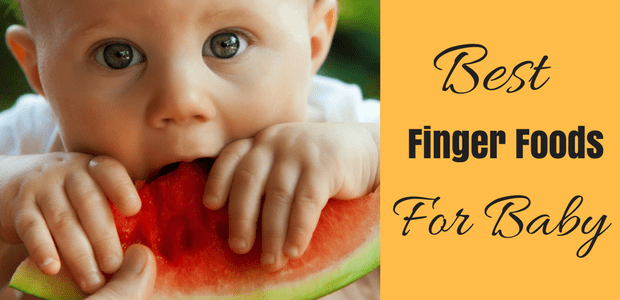
TIP: Find more info on starting solids here and the best foods to start with if doing baby led weaning or purees with baby.
Healthy Baby Food
I love sharing these ideas for baby food since they are easy to prepare and serve and because I know how hard it can be to continue to come up with flavorful and healthy meals and snacks for our little ones. Let me tell you, I’m on my third kiddo and it can be such a challenge to feed him during the chaos of parenting the rest of my crew! These foods are wholesome and nutritious—perfect for your baby.
TIP: I’m a big fan of SpoonfulONE, a company that offers the most complete way to introduce food allergens to our kids. They make mix-ins, puffs, and crackers that are yummy and easy for babies and toddlers to eat. Learn more about their pediatrician-approved baby foods here. (sponsored link)
Best First Finger Foods
When baby is around 9 months, you’ll notice that they’re able to pick up smaller pieces of food with two fingers. This is known as the “pincer grasp” and is a sign that they’re ready to start finger foods. To be clear, when I say “finger foods” I mean small pieces of food that a baby (or toddler) can feed themselves.
This is known as the “pincer grasp” and is a sign that they’re ready to start finger foods. To be clear, when I say “finger foods” I mean small pieces of food that a baby (or toddler) can feed themselves.
Here are some of my favorite ones to start with that are all super soft, safe to eat, and easy to pick up.
- Scrambled egg, broken up into small pieces
- Roasted sweet potato mashed and broken up into small pieces
- Fresh raspberries, broken up into smaller pieces
- Oatmeal, cooked according to package directions and allowed to cool
- Tofu, diced and sauteed lightly or steamed
- Ground beef, chicken, or turkey, broken up into small pieces or lightly mashed meatballs
- Shredded cheese or crumbled goat cheese
- Mashed sweet potato, in little pieces
- Peanut butter puffs
TIP: You can serve the tofu, ground meat, or meatballs in veggie puree from a pouch or a simple marinara sauce for extra moisture and flavor. Learn more about how and why to introduce peanut butter.
Learn more about how and why to introduce peanut butter.
Finger Foods for Baby: Fruits and Veggies
Some of my favorite early fruits and veggies to serve babies are:
- Mashed roasted sweet potato, broken up into small pieces
- Warmed frozen peas, slightly mashed if desired
- Roasted Zucchini
- Diced Roasted Sweet Potato or Butternut Squash
- Fresh blueberries, cut in half or quarters
- Fresh raspberries, broken into small pieces
- Banana, broken into small segments (they are less slippery this way versus slicing them)
- Avocado, diced and mashed slightly (be sure it’s ripe and very soft)
TIP: A good rule of thumb is to serve pieces of food that are about the size of a pea to start and soft enough that they are easy to squish between your fingers. This will be easy for baby to pick up and eat and will also reduce chances of choking.
Finger Food Ideas: Carbohydrates
Offering complex carbohydrates can provide fiber, a variety of textures, B vitamins, and more. Try these with your baby.
Try these with your baby.
- Spinach pancakes (moisten with applesauce or plain yogurt if needed; this recipe is particularly moist and great for babies)
- Oatmeal, cooked according to package directions and allowed to cool
- Baby Puffs
- Peanut Butter Puffs
- Rice (it’s easiest if it’s in little clumps so baby can pick it up; this Coconut Rice or this Cheesy Rice are both good options)
- Baby Banana Muffin
- O cereal (soften in nondairy unsweetened milk or yogurt as needed)
- Baked Oatmeal, diced
Finger Food Ideas: Proteins
Offering proteins will continue to expose baby to a range of nutrients. These are my go-tos for babies newer to finger foods—and toddlers too.
- Shredded cheese (thicker cuts are a little easier to pick up)
- Tofu, diced and sauteed lightly or steamed
- Flaked cooked wild salmon
- Lightly mashed meatballs
- Shredded chicken, cut up finely (we love this Butter Chicken to share with baby)
- Ground beef, turkey, or chicken, broken into smaller pieces
- Lightly mashed beans
- Scrambled eggs, broken up into small pieces
- Diced egg muffins
I’d love to hear any questions you may have, or if you have foods that your babies enjoy that I didn’t include here.
 Chime in below in the comments!
Chime in below in the comments!Prep Time 5 minutes
Cook Time 5 minutes
Total Time 10 minutes
Author Amy Palanjian
Cuisine American
Course Baby Food
Calories 124kcal
Servings 1
First Finger Foods (choose 1-3 per meal)
- ▢ 1 Scrambled egg (broken up into small pieces)
- ▢ 1/4 cup Roasted sweet potato, mashed and broken up into small pieces
- ▢ 1/4 cup Fresh raspberries (broken up into smaller pieces)
- ▢ 1/4 cup Oatmeal (cooked according to package directions and allowed to cool)
- ▢ 2 tbsp Tofu (diced and sauteed lightly or steamed)
- ▢ 2 tbsp ground beef, chicken, or turkey, broken up into small pieces or lightly mashed meatballs
- ▢ 2 tbsp shredded cheese or crumbled goat cheese
- ▢ 1/4 cup Mashed sweet potato (broken into little pieces)
- ▢ 1/4 cup Peanut butter puffs
Fruits and Veggies
- ▢ 1/4 cup mashed roasted sweet potato (broken up into small pieces)
- ▢ 1/4 cup warmed frozen peas
- ▢ 1/4 cup Roasted Zucchini
- ▢ 1/4 cup diced Roasted Sweet Potato or Butternut Squash
- ▢ 1/4 cup blueberries (cut in half or quarters)
- ▢ 1/4 cup raspberries (broken into small pieces)
- ▢ 1/4 cup banana slices (broken into small segments—they are less slippery this way versus slicing them)
- ▢ 2 tbsp avocado (diced and mashed slightly—be sure it's ripe and very soft)
Whole Grains and Carbohydrates
- ▢ 1 Spinach pancakes (moisten with applesauce or plain yogurt if needed; this recipe is particularly moist and great for babies)
- ▢ 1/4 cup Oatmeal (cooked according to package directions and allowed to cool)
- ▢ 1/4 cup Baby Puffs
- ▢ 1/4 cup Peanut Butter Puffs
- ▢ 1/4 cup fully cooked rice (it's easiest if it's in little clumps so baby can pick it up; this Coconut Rice or this Cheesy Rice are both good options)
- ▢ 1 Baby Banana Muffin
- ▢ 1/4 cup O cereal (soften in nondairy unsweetened milk or yogurt as needed)
- ▢ 1/4 cup Baked Oatmeal (diced or regular oatmeal broken into little pieces)
Dairy
- ▢ 2 tbsp Shredded cheese (such as mozzarella)
- ▢ 2 tbsp Tofu (diced and sauteed lightly or steamed)
- ▢ 2 tbsp flaked cooked wild salmon
- ▢ 1 lightly mashed meatballs
- ▢ 2 tbsp finely shredded chicken (we love this Butter Chicken to share with baby)
- ▢ 2 tbsp ground beef, turkey, or chicken (broken into smaller pieces)
- ▢ 2 tbsp lightly mashed beans
- ▢ 1 Scrambled egg (broken up into small pieces)
- ▢ 1 Diced Egg muffins
For each meal or snack, choose 2-3 foods from a mix of food groups.
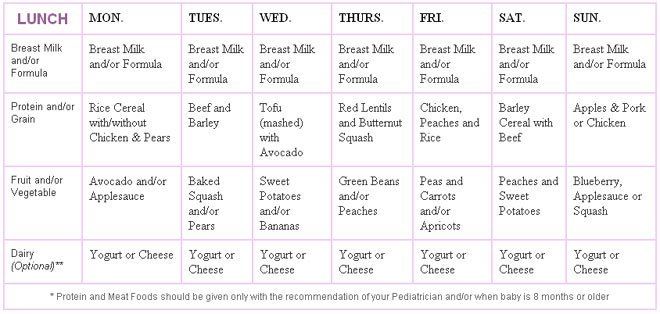 Aim to include some fat in most meals and protein in many too.
Aim to include some fat in most meals and protein in many too.Prepare the food, cutting into small pieces and/or mashing as needed to make the food easy to eat.
Start with small portions and allow more as baby indicates according to their hunger.
- Store leftovers in an airtight container for 3-5 days in the fridge.
- Many foods you cook for your family will work as baby finger foods—just be sure they are easy to squish between your fingers and the pieces are small and easy to chew.
- Babies very normally make a lot of faces when they eat, so don't assume they don't like something just because they scrunch their nose!
- Flavors and textures can take time to learn to eat, so continue offering foods in small portions even if baby hasn't liked them in the past—and make sure they taste good to you!
Calories: 124kcal, Carbohydrates: 14g, Protein: 7g, Fat: 4g, Saturated Fat: 1g, Polyunsaturated Fat: 1g, Monounsaturated Fat: 2g, Trans Fat: 1g, Cholesterol: 164mg, Sodium: 81mg, Potassium: 344mg, Fiber: 4g, Sugar: 5g, Vitamin A: 9857IU, Vitamin C: 18mg, Calcium: 51mg, Iron: 1mg
Tried this recipe?Rate in the comments and tag @yummytoddlerfood on IG!
menu for a week, diet for a 9 month old baby with artificial and breastfeeding
Published: 06/20/2020
Reading time: 5 min.
Number of reads: 222576
Author of the article: Ponomareva Yulia Vladimirovna
Pediatrician, Candidate of Medical Sciences, Allergist-Immunologist
Your baby is 9 months old, and it's time to adjust his nutrition again. The activity of digestive enzymes is already high, teeth erupt in the crumbs, and the volume of the stomach becomes larger, which determines the possibility of increasing the amount of food per feeding and further expanding the diet. What can a child eat at 9months?" - this question very often worries the parents of a grown baby. By this age, the baby's nutrition already includes all the main food groups, and parents should try to diversify the child's menu, expanding the range of his taste sensations. In addition, a varied diet naturally provides a wide range of nutrients. Let's focus on the main food groups that should be on the menu of a 9-month-old baby.
Contents: 9-month-old baby is not enough, so mother's milk should now be no more than a third of the diet.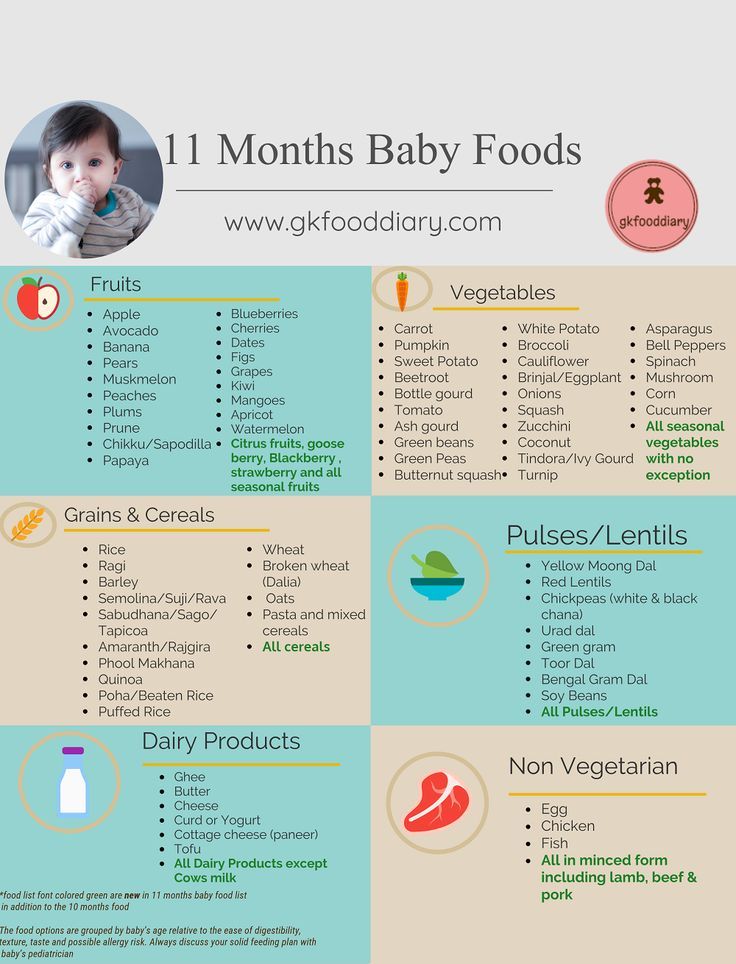 It is best to leave breastfeeding (HF) before bed at night, as well as immediately after waking up in the morning. If the baby is formula-fed, an adapted formula for babies over 6 months of age can be offered at these meals.
It is best to leave breastfeeding (HF) before bed at night, as well as immediately after waking up in the morning. If the baby is formula-fed, an adapted formula for babies over 6 months of age can be offered at these meals.
See also: Complementary foods and dishesmonths in an amount of at least 200 grams per day. It is a source of minerals, vegetable fibers and organic acids. The assortment of vegetables is very wide, which allows them to be evenly distributed throughout the week. In addition to potatoes, zucchini, cabbage, carrots - traditional vegetable complementary foods for children in the second half of life, pumpkin, beets, spinach and tomatoes can be used in the nutrition of a 9-month-old baby. At this age, if the baby is not worried about excessive bloating, the diet can be diversified with legumes. Start with mashed green peas as a side dish with a meat dish or as an addition to a vegetable soup for dinner. nine0003
Fruit and berry complementary foods
Fruits and berries have low nutritional value, but, despite this, they are actively used in the daily diet of a 9-month-old child. Fruits are rich in natural sugars and have an attractive aroma that enhances the palatability of many dishes and is liked by kids. In addition, such food is a source of valuable minerals, organic acids and fiber, which determines its biological significance. It is optimal to include a fruit and berry component 3-4 times a day, it can be a fruit dessert for an afternoon snack, an additional component in the composition of porridge or a curd dish. Every day, a baby can consume up to 90 grams of fruit. By 9 months, it is already permissible for a child to give garden and wild berries, bananas, plums and apricots. Expand the fruit menu consistently and take your time to introduce foods with high allergenic potential, such as citrus fruits, melons, strawberries and exotic fruits.
Fruits are rich in natural sugars and have an attractive aroma that enhances the palatability of many dishes and is liked by kids. In addition, such food is a source of valuable minerals, organic acids and fiber, which determines its biological significance. It is optimal to include a fruit and berry component 3-4 times a day, it can be a fruit dessert for an afternoon snack, an additional component in the composition of porridge or a curd dish. Every day, a baby can consume up to 90 grams of fruit. By 9 months, it is already permissible for a child to give garden and wild berries, bananas, plums and apricots. Expand the fruit menu consistently and take your time to introduce foods with high allergenic potential, such as citrus fruits, melons, strawberries and exotic fruits.
Grain-based complementary foods
Grain-based foods continue to be the most important source of nutrition and energy for a 9-month-old baby. By this age, the assortment of cereals is increasing, on the basis of which you can cook porridge for your baby.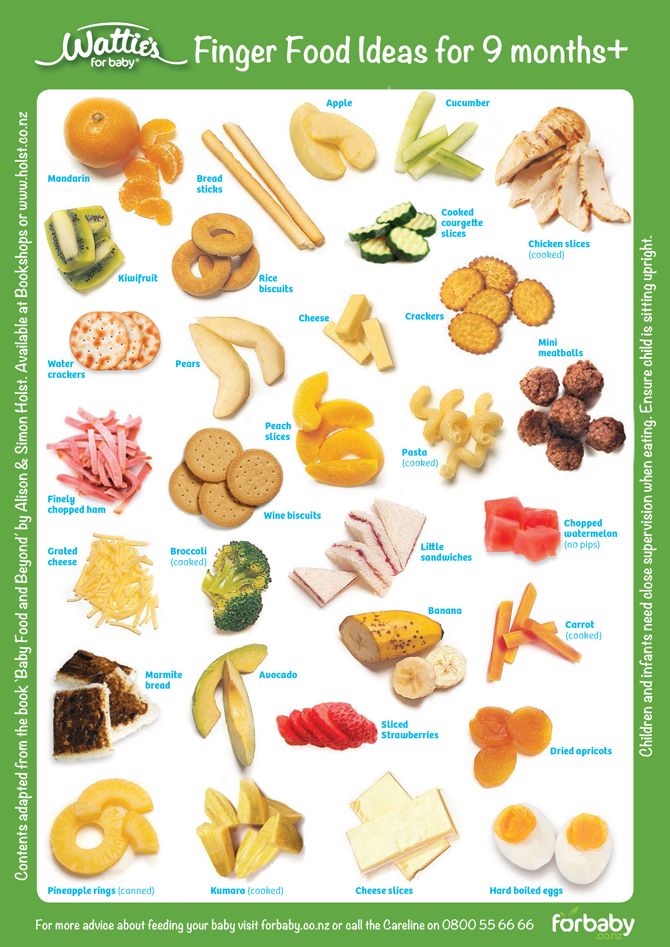 In addition to traditional buckwheat, rice, corn, oat and wheat groats, you can expand the diet with multi-cereal porridge, which may also include rye, barley and millet. When choosing a method for preparing porridge, preference should be given to industrial products. In addition to guaranteed environmental and microbiological safety, the enriched composition provides a daily supply of vitamins and minerals. AT 9months, the child can already eat bread and special baby biscuits without prior dissolution. It is preferable to use wheat bread, no more than 10 grams per day. It is better to dry it before use for easier digestion. Children's cookies are not only a delicacy and a source of energy for the baby, the multi-cereal composition and enrichment with a vitamin and mineral premix favorably distinguishes this healthy food product from traditional bakery products.
In addition to traditional buckwheat, rice, corn, oat and wheat groats, you can expand the diet with multi-cereal porridge, which may also include rye, barley and millet. When choosing a method for preparing porridge, preference should be given to industrial products. In addition to guaranteed environmental and microbiological safety, the enriched composition provides a daily supply of vitamins and minerals. AT 9months, the child can already eat bread and special baby biscuits without prior dissolution. It is preferable to use wheat bread, no more than 10 grams per day. It is better to dry it before use for easier digestion. Children's cookies are not only a delicacy and a source of energy for the baby, the multi-cereal composition and enrichment with a vitamin and mineral premix favorably distinguishes this healthy food product from traditional bakery products.
Meat food
By the age of 9 months, the baby is already well acquainted with meat complementary foods, and he already has favorite combinations with vegetable and cereal products. What changes await him during this period? The development of the maxillofacial apparatus makes it possible to move from puree-like grinding of meat to various options for meatballs and steam cutlets. In the daily menu, meat complementary foods should be at least 60 grams. In addition to beef and veal, turkey, chicken and rabbit, the baby can be offered dishes based on pork, lamb and horse meat. Meat lure is a traditional lunchtime meal. This feeding accounts for up to 40% of the energy needs of the baby, which is satisfied by a rational combination of vegetables, meat and grains. nine0003
What changes await him during this period? The development of the maxillofacial apparatus makes it possible to move from puree-like grinding of meat to various options for meatballs and steam cutlets. In the daily menu, meat complementary foods should be at least 60 grams. In addition to beef and veal, turkey, chicken and rabbit, the baby can be offered dishes based on pork, lamb and horse meat. Meat lure is a traditional lunchtime meal. This feeding accounts for up to 40% of the energy needs of the baby, which is satisfied by a rational combination of vegetables, meat and grains. nine0003
Fish
At 9 months, a new food product appears in the baby's diet - fish. In addition to easily digestible protein, it is a valuable source of iodine, fluorine, phosphorus, iron, zinc and magnesium, as well as a number of vitamins. In the diet of young children, ocean fish is primarily used. This variety is rich in polyunsaturated fatty acids, including omega-3, which are extremely important for the functional maturation of the central nervous system and the formation of the retina. However, fish protein is a powerful allergen, so this type of complementary food should be introduced with caution. Start with a teaspoon of fish puree at lunchtime and keep a close eye on changes in your baby's health. In the next two days, do not give the child any new foods so that there is no doubt about the tolerance of the product. Within a month, the amount of fish puree can be gradually increased to 30 grams, but introduced into the menu no more than 1-2 times a week. nine0003
However, fish protein is a powerful allergen, so this type of complementary food should be introduced with caution. Start with a teaspoon of fish puree at lunchtime and keep a close eye on changes in your baby's health. In the next two days, do not give the child any new foods so that there is no doubt about the tolerance of the product. Within a month, the amount of fish puree can be gradually increased to 30 grams, but introduced into the menu no more than 1-2 times a week. nine0003
Sour-milk products
Specialized non-adapted sour-milk drinks (kefir, yogurt, biolact) can be used in a 9-month-old baby's diet. Unlike whole cow's milk, the protein and lactose in them are partially split, which determines their better digestibility, low allergenicity and a slight burden on the kidneys, provided that they consume no more than 200 ml per day. The most preferred choice among the products of this group are drinks based on probiotic cultures, which have a positive effect on their own intestinal microbiota.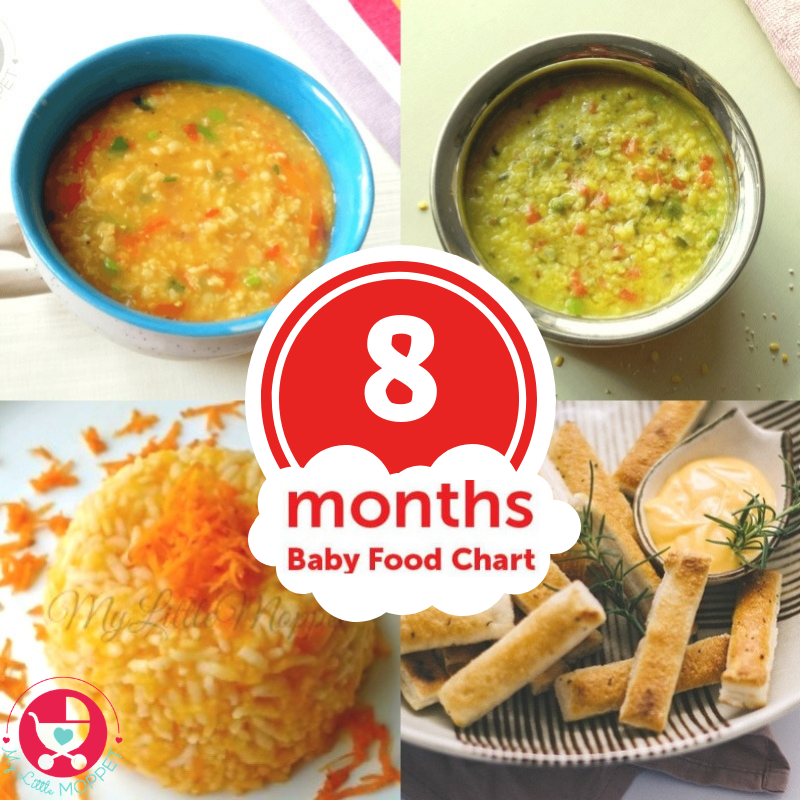 Cottage cheese is a valuable source of calcium and a complete protein in terms of amino acid composition. AT 9months, it is given to a child in an amount of not more than 50 grams per day in combination with a fruit, vegetable or cereal filler.
Cottage cheese is a valuable source of calcium and a complete protein in terms of amino acid composition. AT 9months, it is given to a child in an amount of not more than 50 grams per day in combination with a fruit, vegetable or cereal filler.
Fats
Butter is added to prepared meals in the amount of 5 grams per day, improving the taste of prepared complementary foods, as well as increasing their nutritional and energy value. Vegetable oils are rich in polyunsaturated fatty acids, so they should also be present in the baby's daily menu at 5 grams per day as an additive to meat, vegetable or fish dishes. nine0003
Drinks
Babies meet their physiological fluid needs through mother's milk or adapted formula. But at 9 months, the consumption of mother's milk is noticeably reduced, so it is necessary that the baby receive other drinks. If your child is thirsty, encourage him to drink baby water. The balanced mineral composition and the absence of sugars make it the best option for satisfying fluid needs. Water should be drunk between meals so as not to overload the digestion process. To diversify the diet, you can use specialized children's tea based on extracts of herbs and dried fruits. The pleasant taste of such drinks is combined with a calming and normalizing effect on the digestion process. nine0003
Water should be drunk between meals so as not to overload the digestion process. To diversify the diet, you can use specialized children's tea based on extracts of herbs and dried fruits. The pleasant taste of such drinks is combined with a calming and normalizing effect on the digestion process. nine0003
How to make a diet for the day
The standard diet at 9 months includes 5-6 meals. Each of them is necessary for the even distribution of all nutrients and ensuring vigorous activity during the daytime and a full healthy sleep at night. The table shows an approximate menu for one day for a healthy baby of 9 months.
| Eating | 900 Vegetable puree (zucchini+colored cabbage)/olive oil/yolk | 100/2/2/10 | |||
|
| Meat steamy cutlet | 9000 9000 9000 9000 9000 9000 9000 9000 9000 9000 9000 9000 9000 9000 9000 9000 9000 9000 9000 9000 9000 9000 9000 9000 9000 9000 9000 9000 9000 9000 9000 9000 9000 9000 9000 9000 9000 9000 9000 9000 9000 9000 9000 9000 9000 9000 9000 9000 9000 9000 9000 9000 9000 9000 9000 9000 Dried wheat bread | 50003 | Breast milk/adapted formula | 200 |
Rate the article
(Number of votes: 26, average 4.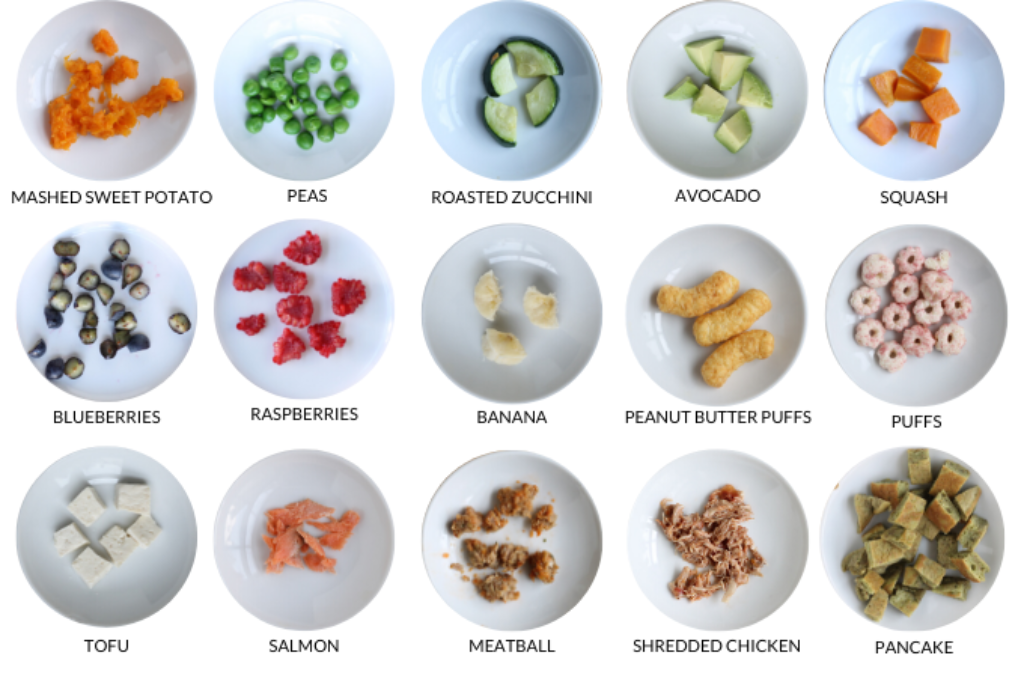 8)
8)
Share with friends:
Baby food that can be eaten with your hands - Encyclopedia Baby food
Finger food
Levchuk Victoria©
Healthy baby food recipes are worth trying to stimulate your child's interest in food. Children's food, which is eaten with their hands, should not exceed the size of a small box of porridge. It is also necessary to take into account that the child needs to be offered products that are age-appropriate and soft like mashed potatoes.
Baby finger food can be any food that the baby likes and is age appropriate.
A child does not need teeth to chew. Babies use their gums to soften food until their molars appear between 12-18 months of age. nine0003
TIP: Puree food or cut into small pieces to make it easier for your child to chew.
Table of Contents:
Fruit Ideas You Can Eat With Your Hands
Fruits are colorful and highly nutritious, small soft pieces of fruit can be eaten with your hands. Fruit is an excellent food for a child, which is eaten with the hands, just be sure to remove the seeds and bones.
Fruit is an excellent food for a child, which is eaten with the hands, just be sure to remove the seeds and bones.
- soft baked peaches - diced
- Small Banans
- Small pieces of ripe apple
- ripe pears
- Small plum cubes
- Small pieces of apricot
- Blueberry with a fork
- finely chopped fruit, mix for fruit salad (you can eat more than more three types of fruit)
To make the fruit show itself in a new way, sometimes it is enough to sprinkle it lightly with spices or wheat germ.
Vegetable ideas that you can eat with your hands
Vegetables are like fruits, you can eat them with your hands; make sure the vegetables are soft, cooked, seeded and peeled as needed:
- soft cubes of baked sweet potatoes
- soft cubes of baked white potatoes
- small cubes of soft boiled carrots
- small cubes of soft peas small
- cubes of soft boiled broccoli
- small pieces of soft boiled green beans
- small pieces of soft boiled pumpkin or zucchini
- large cubes of soft boiled vegetables mixed as a vegetable salad (no more than three types of vegetables)
You can try frying some of the vegetables - make delicious snacks! Do not forget about herbs and spices to improve the taste.



